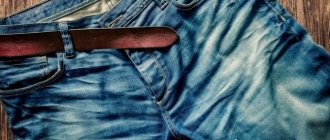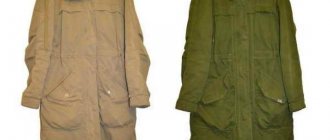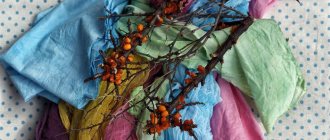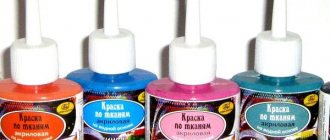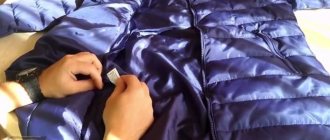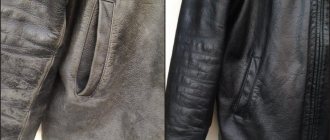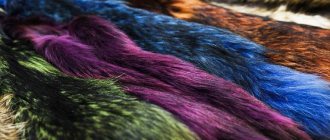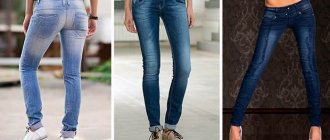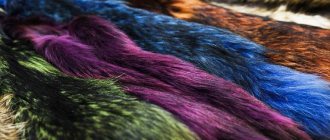Many people have favorite jeans. The only problem is that sooner or later they lose their color. Jeans wear out, become faded and unattractive to the point that they are no longer suitable for everyday use.
But jeans can be updated: dye them in dark shades or give them a bright color. Denim absorbs dye well and, due to its durable structure, can be re-dyed several times.
Methods of application
The choice of coloring agents is quite diverse, each of them has its own nuances in application: some come with a fixative, others do not.
You must apply the paint strictly following the instructions, otherwise you may end up with either a poorly painted product or a completely damaged one. Before you begin the process of “reviving” the color, the jeans need to be washed well, but without using conditioner, and dried
When painting, it is important to pay special attention to the areas that are subject to the most rubbing, so check how the original paint looks on your knees
Step-by-step instruction
Dyeing a denim item in black or any other color begins with studying the information indicated on the packaging of the dye. At home, it is most convenient to use a washing machine. The step-by-step staining process is as follows:
- the pockets of the product are checked for contents; everything must be taken out;
- study the jeans tag, it should indicate the washing temperature at which they can be washed;
- turn the product inside out and place it in the drum of the washing machine;
- the denim product must be sprinkled with dye in the required amount on top;
- The washing machine is set to a washing mode without rinsing;
- after turning off the machine, take out the jeans and rinse them in a weak vinegar solution (1 tablespoon of vinegar is added to 1 liter of water);
- Next, the jeans are re-loaded into the machine, but they need to be washed with the addition of powder for colored fabrics. The washing mode is set to normal, i.e. with rinse and spin;
- The clean and freshly painted product is dried naturally.
The step of rinsing the product in vinegar water is only needed if the paint does not contain a color fixer.
Some dyes are loaded into the drum along with the packaging; there is no need to pour anything out.
The paint is absolutely safe for both denim and the washing machine. After the first rinse, no dye remains on the drum and even white items can be washed.
Video: how to dye jeans black?
Painting of any complexity in dry cleaning
Modern dry cleaners are equipped with special equipment and have all the necessary means for dyeing any products made from 100% cotton and more. Specialists probably know how to dye the clothes they process.
When accepting orders, employees typically identify possible risks to customers, especially when it comes to problematic fabrics and materials that are prone to shrinkage. Dry cleaning services are provided not only for dyeing clothes of any color, but also for restoring the original shade. Products are accepted for work only after all details have been agreed upon with the technologist, which is important in such cases.
Now you know how clothes are dyed, and you can evaluate your chances of doing it yourself at home. We hope that whichever method you choose, you'll get a good result - a refreshed and vibrant piece that will continue to highlight your personal style for a long time.
Steps
Part 1 of 3:
Preparing jeans for dyeing
- 1
Wash your jeans.
To ensure that there are no substances left on the jeans that you are going to dye that could interfere with the dyeing process, they must be washed first. Place them in the washing machine and wash as usual, following the care instructions on the jeans' sewn-in label. X Source of information
- There is no need to dry your jeans after washing. They must be wet before bleaching or dyeing.
If you have blue or light-colored jeans that you don't intend to bleach, the only thing you need to do before dying is to wash them. In this case, you can skip the rest of the steps in this part of the article.
Part 2 of 3:
Preparing the Paint
- Part 3 of 3:
Dyeing jeans
1
Press out any wrinkles on your jeans.
Jeans should be wet after washing. Before putting the jeans into the pan, squeeze them out again to make sure there is no excess moisture left in them. Then straighten the jeans so that when you dip them into the dye, there are as many wrinkles as possible. X Source of information
- 2
Place the jeans in the pan and stir them in the solution for a while.
Dip the straightened jeans into the paint pot. Using a large, long spoon, stir them for 30 minutes or until they are as black as you want them. X Source of information
- As you stir the jeans, move them back and forth, up and down. It is necessary to ensure that the dye evenly saturates the denim fabric.
Be careful not to twist or wrinkle the jeans due to stirring. This may result in uneven coloring.
- 3
Remove jeans from pan and rinse thoroughly until clean.
When you are happy with the results of dyeing your jeans black, remove the pan from the stove and transfer the jeans to the sink. Rinse them in the sink with warm water. Gradually start making the water colder until all the excess paint is washed away and the water runs completely clear. X Source of information
Some dyes may come with a dye fixative for cotton fabrics to prevent fading. It can be used to treat jeans immediately after dyeing in accordance with the manufacturer's instructions provided.
- 4
Hand wash your jeans.
After dyeing your jeans, hand wash them directly in the sink. Use warm water and liquid detergent for hand washing. Then rinse your jeans with cool water. X Source of information
If you want, you can wash your jeans in the washing machine along with an old towel. The towel will absorb any excess paint that comes off the jeans.
- The first few times you machine wash and dry your jeans, be sure to add an old towel or other dark item to them in case the dye continues to wash out. To prevent paint from fading, use cold or warm water and a gentle liquid detergent.
- It is obvious that textile paint leaves behind stains on fabric surfaces. For work, wear old clothes that you don’t mind getting dirty during the process of dyeing jeans, and also protect your hands with rubber gloves. Clear your workspace of textile items, including towels, rugs and curtains.
- Be careful when wearing freshly dyed jeans. They can leave marks on light-colored upholstered furniture, even after the paint has set. Be sure to rinse them thoroughly after dyeing.
- Even after several dyeing procedures, the jeans will not become as deep black as store-bought black jeans. Be realistic in your expectations.
- Washing machine
- Machine washable detergent
- Large stainless steel saucepan
- Big long spoon
- Water
- Latex gloves
- Bleaching agent
- Jeans
- Disposable polyethylene tablecloths
- Liquid or powder black paint for textiles
- Salt
- A piece of cloth or paper to test the dye
- Liquid detergent for hand washing
Hot way
You can also dye jeans manually by boiling them in a dye solution. First of all, denim is processed in this way with aniline and most other powder dyes.
For this method you will need the same equipment as for cold dyeing. In addition, you need to stock up on wooden tongs or two long sticks for turning the product over. The process of dyeing jeans occurs in the following sequence:
- Dissolve the dye in a glass container following the directions on the package. If necessary, filter the resulting mixture through cheesecloth so that there are no lumps that will prevent the paint from laying evenly.
- The prepared composition is poured into a container with water, baking soda (1.5-2 tbsp) is mixed into the solution. For denim in dark shades, you can add 2 tbsp. l. substances.
- The mixture is put on fire and wait until it reaches a temperature of 60°. If foam from soda forms on the surface, it must be removed.
- Wet jeans are dipped into the container and, periodically turning them with tongs or sticks, heated for about half an hour.
- Add 2-5 tbsp to the solution. l. salt to deepen the color and increase the heat, bringing the water to a boil.
- Light jeans are boiled for half an hour, dark jeans are boiled for 15-30 minutes longer, black jeans are boiled for up to an hour and a half.
- When the specified time has passed, turn off the fire and let the item lie in the solution for about a quarter of an hour.
- Then the jeans are rinsed. The water should be changed until it stops being colored. During the last rinse, vinegar is added to the basin.
When dyeing cotton in dark colors, the ratio of the weight of the product and the volume of liquid should be 1:20, in light colors - 1:30 or 1:40.
photo: depositphotos.com/ivan_dzyuba
Digestion is also used when processing cotton with natural dyes. Here are a few recipes as an example:
- Henna is diluted according to the instructions in a ceramic bowl, dissolved in hot water and trousers are boiled in it for half an hour.
- Add cinnamon (ground coffee or tea leaves) to hot water (2 tablespoons per 1 liter) and bring the mixture to a boil. The fabric is boiled in the solution for 10 minutes.
- Dry onion peels (4 handfuls per 1 liter of water) are boiled for a quarter of an hour, then a cloth is placed in a container and heating is continued for another 10-15 minutes.
After final processing, the jeans should be immediately hung on a line to dry. If you leave them in the basin, unwanted stains may appear on the denim.
Is it possible to dye a Bolognese jacket?
Before painting the jacket, it must be soaked in hot water. This is necessary to ensure that the paint is evenly distributed throughout the product. You can soak it in the bathtub or in a basin. After this, take out the jacket and smooth out all the creases so that the paint adheres correctly. Heat water in a large saucepan; there should be enough water to completely cover the item.
Important! The jacket should float in the water so that the pigment is evenly absorbed. It is advisable to choose a very large pan
Over medium heat, boil water. Next, pour water into a large basin and put the jacket there.
Painting a nightgown
The water temperature should be approximately 70 degrees. Add paint to boiling water and stir quickly. One package of pigment requires at least 10 liters of liquid. For a less vibrant color, less water is needed. The paint is dissolved in a separate container. Pour 250 ml of boiling water over the powder packet and stir. Even liquid dyes are first diluted with water. To make the color more saturated, you can add a spoonful of vinegar to the water. Dye the jacket for about 2 hours.
How to paint a product yourself
Textile paint is available in the following forms:
It is suitable for use when dyeing by hand or in a washing machine. The choice of dye depends on the composition of the fabric and the personal preferences of the owner of the clothing.
Before starting work, it is necessary to accurately determine the composition of the product. If the label is erased or lost and it is not possible to find out reliable information about the composition, you can set fire to the thread from the product. Synthetic and natural fibers release different “flavors” when burned:
- synthetics smell like chemicals;
- natural wool or cotton emits the smell of burnt hair.
The easiest way to repaint a thing is from natural materials. Synthetics are difficult to paint and quickly lose their newly acquired shade.
The general rules for using universal fabric paint are the same regardless of the manufacturer of the product. However, when starting coloring, it would be useful to study the instructions included with the product in order to know exactly the dosage and nuances of using a particular dye.
Important! All work with the dye must be carried out with rubber gloves. If the dye does not require heating the water, then it is better to carry out the work in the bathroom, having previously protected easily soiled items with a waterproof film
Then the following activities are carried out:
If the dye does not require heating the water, then it is better to carry out the work in the bathroom, having previously protected easily soiled items with waterproof film. Then the following activities are carried out:
- Pour paint into a container with warm water and stir thoroughly. The amount of water and dye is determined in advance depending on the weight of the clothing and the dosage indicated by the manufacturer on the packaging.
- The product is dipped into the solution and left for half an hour, stirring occasionally and making sure that the fabric does not wrinkle.
- As soon as the product acquires an intense black color, it can be removed from the solution and rinsed in cool water, adding 1 tbsp. l. vinegar.
Important! If you need to paint several things, you need to paint them one by one. Often the instructions require heating the coloring solution, then proceed as follows:
Often the instructions require heating the coloring solution, then proceed as follows:
The container with paint dissolved in water is placed on low heat and heated to a temperature of 60 °C.
Important! When dyeing wool and silk, add 50 ml of 25% vinegar essence to the solution
- The item prepared for painting is immersed in a hot solution for an hour, maintaining a constant temperature of no more than 60 ° C and stirring occasionally.
- After the allotted time has passed, the product is washed in a machine or by hand at a water temperature of 40 ° C and rinsed with the addition of vinegar.
In the future, you should wash and rinse items painted black separately from the rest of your clothes, and add vinegar to each rinse.
How to choose paint
- Compound. Before purchasing, you need to pay attention to whether the ingredients of the product are listed on the label. In the production of counterfeit paints and compositions that are produced in artisanal conditions, important information is often missing, including the types of main components. In addition, the composition allows you to determine how high-quality and effective the chosen product is. Thus, it is recommended to purchase a helmet that does not contain lavsan and niton. These components can ruin the item because they contribute to its uneven coloring.
- Material type. The label indicates for which fabrics the composition is intended. If the wrong product is used, the material may be colored unevenly or may result in a color that is not what was expected, such as a lighter color. There is another danger: the material will be colored, but after the first wash it will begin to fade a lot.
- Type of paint. The compositions differ in structure, which determines their properties. The choice is made taking into account the method of application of the pigment. This is due to the fact that each type of paint is designed to paint products under given conditions. When the requirements for the procedure are not met, the quality of the painting deteriorates.
- Application of universal compositions. In the absence of information about the type of material, it is permissible to use a product that is suitable for dyeing cotton, linen, wool, silk, and viscose fabrics. In this case, the color can be preserved for a shorter period than in the case when a highly specialized composition is selected.
- Best before date. It is not recommended to use products that have lost their properties.
Is it possible to dye jeans blue?
Water-soluble and water-insoluble dyes can be used as a blue for dyeing jeans. These can be liquid or powder.
It could be:
- Prussian blue;
- indigo carmine;
- Paris blue;
- ultramarine;
- anilic dyes.
All these types of dyes can be used when dyeing jeans, you just need to take into account some of the characteristics of the dyes. For example, Prussian blue can only dissolve in water together with oxalic acid. Anil dyes become discolored in the sun, some of them acquire a reddish color when ironed. Ultramarine is quite cheap, but it does not dissolve. Insoluble paints stain fabric worse and are more difficult to work with. There may be difficulties due to uneven dyeing, especially on heavy items: insoluble crystals can stain clothing in the form of stains.
It should be taken into account that if there is embroidery on jeans, it will inevitably deteriorate and turn blue. The item will look washed out and untidy, and bright embroidery threads will have a dirty effect.
Denim items in shades other than blue cannot be dyed blue. Blue and light blue shades that need to be refreshed or re-tinted can be used. It is acceptable to dye white and light gray jeans, which will turn blue when used with bluing. The final shade will in any case depend on the original color.
What materials cannot be painted?
It’s not difficult to dye clothes at home, but it’s important to understand in advance whether the fabric can withstand such aggressive exposure, otherwise you’ll just waste your time and ruin your favorite item.
It is not recommended to dye fabrics with a high percentage of synthetic fiber at home. Initially, they may change shade after the procedure, but the paint is quickly washed off after the first wash.
Important!
Only dry cleaning specialists can handle this kind of work, because in such cases it is necessary to use special technologies and special paints.
You can safely try dyeing wool and cotton fabrics at home.
How to dye jeans at home
Various means allow you to dye jeans in almost any color. The dyeing process is as simple as possible; even someone who has never dyed fabric can handle it.
How to paint jeans with powder paint or other means
Choose a product depending on what color you want to get.
- Blue. Almost all housewives have it in their arsenal. Updates the blue color of jeans. Not very durable, you will have to periodically dye your jeans again.
- Potassium permanganate. You need to work with it carefully, otherwise you risk severely staining your hands, your pelvis, and your bathtub. However, potassium permanganate will help you create stylish “washed” jeans that are always in fashion.
- Aniline dyes. The easiest option to use. They are not very durable.
- Powder paints. Also very easy to use, and also very durable. The downside is the small selection of colors.
- Acrylic paints. They are a little more difficult to use, but there are a lot of color options. Acrylic is absolutely not afraid of washing; jeans can fade only if you decide to boil them.
The described paints can be purchased at fabric stores. They're relatively inexpensive, so you can update your favorite jeans at minimal cost.
Types of Dyes
Retail outlets offer a variety of dyes for shoes and clothing. Fabric paint is sold in various forms. We’ll look at how to dye fabric with brilliant green or other dyes below. The most popular fabric paint:
- acrylic
- aniline
- stamped
- plastisol
- natural
Acrylic paints
The most popular water-based fabric dye is safe for human life and health. Easy to use, does not wash out after dyeing. After painting, it is better to wash products at a temperature of no more than 35 C.
Aniline dyes
They are painted at a temperature of about 95 C, fixing the color by adding salt. For cotton, soda is also added, and for wool, vinegar is added. The product may fade for some time. The technique is called “batik”. In the “gradient” technique, the material is lowered in parts, resulting in coloring of varying intensities. If you squeeze too hard after painting, you will get streaks.
Stamp inks
With their help, hospitals, hotels and other government institutions label bed linen, towels, and bedspreads. They have different compositions, which depend on their application.
Plastisol paints
They are applied to outerwear, shoes and accessories as it has the property of reflecting light in the dark or under the influence of ultraviolet radiation.
Natural paints
Before chemical dyes began to be produced, natural dyes were used. They are less durable and the intended color is not always obtained. But they are hypoallergenic and suitable for people with sensitive skin and allergic diseases. There are many natural coloring substances known: turmeric, onion peel, orange peel, blueberries, blackberries, beets. A sufficient amount of paint is added to the water, the item is placed in it, heated to 60 C, and the procedure lasts up to 40 minutes.
Preparing for painting
Before you start work, you need to prepare everything you need, namely:
- things intended for dyeing;
- container and devices for turning fabric;
- dyes and rinses.
Selecting containers and equipment for coloring
Once the clothes are prepared for dyeing, you can begin choosing a container.
Any clean utensil will do, be it an enamel basin or an aluminum pan.
The main thing is that there are no traces of scale or soot on the inner surface of the metal. Particular attention should be paid to the size of the container. The pan should be of such a volume that the thing to be painted is located freely in the solution, does not squash and does not rise above the surface of the water.
To stir and turn the product while working, you will need wooden tongs. If you don’t have such a device on your farm, you can use ordinary wooden sticks, after first clearing the surface of knots and uneven surfaces.
It is better to take soft water for the procedure, for example, rain or melt water. If this is not possible, then ordinary tap water can be softened with baking soda, for which 1 tbsp. l. powder is dissolved in 10 liters of water.
Cold dyeing method
The cold method of dyeing jeans is the easiest to perform. It is especially relevant if it is not possible to purchase a special dye, for some reason it is impossible to do this in an automatic machine, or you do not want to stand near a hot stove.
What you will need
For it you will need:
- large (unnecessary) stainless steel or enamel-coated container;
- plastic or rubber gloves;
- small container made of plastic or glass;
- wooden or plastic spoon.
The nuances of cold dyeing depend on the type of dye. Here is the sequence of working with different types of dyes.
Blue
The easiest way to dye jeans blue is to use methylene blue. You need to do this:
- Fill the container with water and begin to gradually pour blue into it, stirring the solution periodically.
- When the color saturation of the solution seems satisfactory, add food or Glauber's salt (1 tablespoon per 3 liters) as a fixative.
- The wet product is immersed in the resulting mixture for 2 hours (during this time the jeans need to be turned over several times), then rinsed in several waters.
- Water for the last rinse is mixed with vinegar (1 tbsp per 1 liter) so that the products shed less.
Hair dye
Dye your jeans black, and also give them unusual shades with hair dye. The product is prepared in a glass container, stirring the concentrate with a non-metallic spoon, then, stirring, add to warm water until the required tone is obtained. The product is kept in the solution for 1.5 hours, then rinsed in a fixative and washed.
The dye can be applied directly to the fabric using a brush and then rinsed off, just like when dyeing hair.
Industrial dyes
Some industrial dyes, for example: DYLON, also act on fabric in cold water. The paint is dissolved separately, according to the instructions, then added to a bowl of water along with 5 tbsp. l. salt.
The dyeing time for jeans is 1 hour. During the first quarter of an hour, the product must be turned over frequently. In the remaining time, its position is changed only a few times. Dyed denim is rinsed and washed, as in the previous case.
In order for the dye to dissolve more efficiently, the water in the container is softened with baking soda or ammonia (1 tsp or 1 tbsp per 10 liters of water, respectively).
Painting stages
When everything is ready, we move on to painting the products. Following the instructions, pour the dye into a small bowl. Add water gradually, stirring the paint thoroughly until it is completely dissolved. Now strain the dye solution and pour it into the container in which the product will be dyed. Dilute the paint with water until it completely covers the item.
Place the container on the stove. Now you can immerse the product in the dye. To obtain a uniform color, rotate the fabric in a circle using a spatula or sticks. You need to remove the product when it becomes darker in color than you want. The fabric will lighten as it dries. To get streaks, the product must be twisted, as if wrung out, and secured with rubber rings.
Rinse the painted material well in water. After the last rinse, the water should remain clean. The better you rinse the fabric, the less it will shed during subsequent washes. Do not dry painted items in the sun or near a stove.
How to dye things with natural dyes
Miss Clean magazine recommends adhering to the following rules when dyeing using natural products:
- Test the natural product on a small piece of fabric before painting.
- Fill the selected raw material with water in a ratio of 1:2. Place on the stove, bring to a boil, then immediately remove. Now let the future dye brew. The longer the raw material is infused, the richer the color will be.
- It is necessary to prepare the tissues by immersing them in a fixing solution. For berries: 0.5 cups of salt per 2 liters of water; for vegetables: vinegar + water in a ratio of 1:4.
- Now things can be immersed in dye. Keep them until you get the desired shade. Remember that the fabric will become slightly lighter as it dries.
- Dry fabrics on a hanger, this will help avoid streaks.
Selection of paint for jeans
Again and again we will repeat the golden rule about reading instructions. There are so many dyes sold that it would be pointless to describe each variety in detail - no one will ever remember it. A single misstep can transform your modest everyday jeans into a stage costume, or from college party king to an overgrown Ohio high school senior.
In order to somehow protect you from such unplanned transformations, let’s go over the basic principles of selection and types of paints to dye jeans blue at home.
Soluble or insoluble?
Simply put, powder or solution? If you are a lazy and undemanding person, the choice in favor of a ready-made liquid reagent is quite obvious for you. But it's not that simple. Coloring and coloring are different. Some people want to change the color of their jeans, others just want to freshen them up.
Manufacturers have learned to take this point into account and began to produce dyes intended for different purposes. It is generally accepted that:
- liquid dyes for jeans are better for modest plans to restore the color at least a few washes back;
- To completely change the color or add new shades to the color scheme of the pants, it is better to choose a powder dye composition for jeans.
Aniline dyes
At first glance, the simple procedure for dyeing fabrics, as you have seen, is full of many subtle nuances in which it is easy to get confused. How not to make a mistake with the shade, with the type of dye for jeans, with the method of heat treatment?
Help in choosing a shade are color tables, which are sometimes supplied with instructions for dyes. In them you can see how rich shades can be obtained at different concentrations of the active substance. But these are shades.
What about chemical formulas?
If you are not sure that you remember the school chemistry curriculum well, focus on aniline dyes. Aniline dye for jeans is not without reason considered the most popular and reliable.
The principle of action for dyeing jeans blue at home with aniline products is generally the same: boil and soak in a vinegar solution. There are just a few minor details:
- table salt, which in other cases is added at the discretion of the owner, or in accordance with the instructions, is mandatory for aniline dyeing, otherwise the color will quickly disappear;
- difficulties may arise with the dishes in which your jeans will be dyed: when cooking, you need to straighten them as much as possible, therefore, your dishes must be wide enough, and you will not be able to boil the bath;
- You can play it safe by using a large wooden spoon or stick, stirring the solution itself.
Dillon
If aniline dyes for jeans are an enduring classic of the genre, then the universal product for tinting and washing denim “Dilon” is a newcomer that is confidently gaining popularity. The reason is clear: a product that is equally suitable for dyeing and washing, firstly, saves money and nerves, and secondly, it is much easier to use in practice.
Try it, use it and have fun. And remember the golden rule: if after dyeing the result is not at all what you expected, just tell yourself and your loved ones that everything was as planned and you wanted to dye your jeans at home exactly that blue color.
But we don’t say goodbye to you here, come back again!
With love, Stay tuned!
Types of dyes
Industrial production means:
- powder compositions: paint is available in dry form, in powder form;
- Ready-to-use liquid products are specially developed pigments intended for dyeing fabrics.
Use available tools:
- refilling printer cartridges (black);
- natural coffe;
- tobacco ash.
These options are not recommended for improving the color of expensive items, since there is a high probability that the trousers will be irreparably damaged. There is no guarantee of a good result in this case.
How to dye black trousers in the washing machine?
Dyeing trousers in the washing machine is easy. The paint packaging details the painting steps, but if the instructions are in Chinese, English or another language, then it is unlikely to be useful. Let's look at the detailed dyeing of black trousers in the washing machine. To do this you need to do the following:
Before painting black trousers, you need to wash them in washing powder, using a stain remover, but under no circumstances use fabric softener. After washing, you can proceed to dyeing.
Put on rubber gloves and pour two to three packets of dye into a glass bowl. Then pour the dye with hot water - at least 2 glasses of water per 1 package of dye. Mix well with a metal spoon so that the paint is completely dissolved in the water. Then add 1 cup of coarse salt and mix well again.
The dye for dyeing black trousers must be completely dissolved in water.
Fill a basin with hot water, add a mixture of dye, salt and water, also add 1 glass of vinegar and 1 tablespoon of washing powder, mix thoroughly and pour the finished mixture into the washing machine.
Observe the concentration of dye, salt, vinegar and washing powder
Place wet jeans in the washing machine and set the wash cycle to no more than 30 minutes. When the wash is finished, take out the pants and rinse several times until the water runs clear and hang to dry.
To dye trousers in the washing machine, it is better to use a top load machine
Using a washing machine to dye black trousers can achieve long-lasting color and uniform dyeing.
Useful tips
For competent and complete coloring, you must follow several recommendations.
- For high-quality dyeing, it is recommended to use a dye suitable for the given fabric .
- When painting in a washing machine, the mixture must be poured into the drum, and not into the window for washing powder .
- You can add a little black paint to get a darker blue hue..
- A solution of vinegar and salt is required when rinsing . It helps consolidate the result and prolong its quality.
- Before dyeing, trousers must be washed and all stains removed . When stained, they will reappear on the product.
How to dye jeans
Denim is a natural material that can be easily given almost any shade.
Before choosing a method to update the color, you need to decide how to dye your jeans and what products to use.
To update your jeans at home, you can use the following products:
- The most common painting option is blue. This method is very simple, but the result will not last long.
- So-called boiled jeans can be obtained using potassium permanganate. In this case, the result depends on skill and experience, since the process is quite complex.
- You can purchase ready-made aniline dyes. By following the instructions on the package, you can quickly get the desired effect.
- To obtain a more durable result, acrylic paints are suitable.
- Jeans can also be dyed in the washing machine using powder dyes. The painting process is simple, but there is a small selection of shades available.
Blue
Affordable and inexpensive painting options include bluing. But, using this product, it will not be possible to radically change the color of the product; you can only make it blue.
Blue can be purchased at any hardware store.
How to dye jeans blue:
- Dilute the blue in water whose temperature is less than 30 degrees. The brighter the color you want, the more product you need to use. To get a lasting shade, you can add 2 tablespoons of salt to the solution.
- Place the jeans in the solution.
- Leave them for a couple of hours. To ensure uniform painting, the product must be turned over periodically.
- Rinse your pants in cold water.
- To fix the color, rinse them in a weak vinegar solution.
The resulting result will begin to wash off immediately after the first wash, so this method of painting cannot be called optimal.
Powder painting
Painting jeans with powder paints will not harm your washing machine.
Using powdered dye and a washing machine, you can dye your jeans black. To avoid unexpected results, do not add washing powder and fabric softener to the washing machine. Jeans need to be washed first.
How to dye jeans in the washing machine:
- turn the product inside out;
- place the jeans in the washing machine;
- pour coloring powder into the drum;
- set the washing temperature specified on the product label;
- start the standard washing program;
- take out the painted item and rinse in cool water;
- rinse your jeans in a vinegar solution;
- wash them in a washing machine with washing powder;
- dry.
The result of dyeing is a durable, bright color. You should not worry about the washing machine - the use of dye will not affect its functionality in any way. The maximum that can happen is painting the rubber seals. But this problem can easily be solved by wiping them with a damp cloth.
Acrylic paints
Using acrylic paints, you can apply any design to the fabric, which will help hide problem areas and make the item unique and inimitable.
The process will require acrylic paint, brushes of suitable sizes with stiff natural bristles, and an iron. After the design has been applied to the fabric, the product must be ironed from the wrong side.
But this method is short-lived, since after several washes the color of the paint will begin to fade, and may even begin to fade. Therefore, this method is not suitable for everyday items that are often washed.
Aniline dyes
Among textile dyes, aniline dyes are the most popular. This is due to its ease of use and lasting results.
To correctly calculate the dosage, before starting work you need to read the instructions and recommendations on the packaging.
To dye jeans, you need to boil them in a dye mixture with salt, stirring occasionally. Then rinse in vinegar solution and dry.
What dyes are used to dye fabrics?
At home, you can dye your clothes with special dyes, which are natural and aniline. Let's look at each option separately.
Natural colors
Natural dyes must be crushed before use, then boiled in water and evaporated slowly to produce the desired shade. We filter the finished mass, and it is ready for use.
Important
! Getting such paints is not a problem, for example:
- If you want a cream or beige color, you can use tea or coffee. To dye an item, place it in the ready-made dye and hold it until it reaches the correct shade.
- Green dye can be obtained from elderberry leaves, juniper berries and marsh grass.
- Yellow shades are extracted from barberry bark and birch leaves, as well as from turmeric.
In this case, you can experiment as much as you like.
Aniline
Aniline dyes should be used carefully, but before doing so, you must carefully study the instructions. From it you will learn which fabrics and which products are best to use in each specific case.
Important!
These are the products used to dye things in dry cleaners.
You will not have any problems with these paints at home, the main thing is to correctly determine the required amount of dye. It's easy to do, you just need to weigh your clothes.
Important!
If you need to color several objects, it is recommended to work with each of them separately. Before the procedure, all items are washed and all decorative elements are removed from them.
How to quickly and efficiently dye jeans black?
Redying your favorite trousers in a rich and uniform black tone will not cause any trouble if you follow the technical recommendations for the process. Before you dye your jeans black, you need to wash them again to make sure there are no greasy stains or streaks. It is forbidden to add rinse conditioner during the washing process; it can affect the quality of the final result.
The easiest way to dye is using a powder composition for high-density fabrics and a washing machine. You just need to strictly follow the instructions. If it is in an incomprehensible language, then most often the procedure comes down to sequentially performing the following manipulations:
- We check the trouser pockets for items and turn the jeans inside out. We place them in the drum, and pour the dye into it.
- We set the optimal washing temperature for a given fabric (check it on the label) and start the standard cycle. No powders or rinses are used.
- If the powder does not contain components intended to fix the color, then after washing the product, rinse the product again in water and vinegar.
- After all the steps, the trousers need to be washed again, this time in the most usual way, with the addition of powder or gel. Dry your jeans naturally.
This type of processing will not harm the machine in any way, so don’t worry about it. Only the rubber inserts may become slightly stained, but the deposit can be easily removed with a damp sponge.
Product preparation
When preparing trousers for dyeing, the following conditions must be met:
- Wash the material. In places where there are traces of dirt, the clothes will stain worse.
- Bleach your pants using laundry soap, hydrogen peroxide, or a specialized product based on chlorine or oxygen. This will help restore deep color.
- Remove buttons and metal objects.
- Before the procedure, cotton and linen clothes should be boiled for 20 minutes in a solution of soap and soda. After this procedure, the material is rinsed.
It is recommended to dye trousers in distilled water. If you use tap water, then you need to add a spoonful of soda to the latter (for every 10 liters). Coloring is done in enamel or glass containers. Also for this procedure you will need two wooden spoons (sticks), with which you will turn the trousers over. It is recommended to work with rubber gloves.
Dyeing technology
Dyeing by hand and using a washing machine is different, so we will analyze each technology separately. The algorithm for manual painting will be as follows:
- Dilute the black dye with water according to the instructions on the package, then pour the solution into a large container.
- Place the trousers in a bowl of dye and leave for 30 minutes. You can adjust the exposure time of the paint on the fabric yourself depending on the color you want to get as a result.
- After the required time has passed, transfer the product to a container of water and leave for 3-5 minutes.
- At this time, pour the coloring solution into an enamel pan or bucket and place it on the fire.
- Next, put your pants back into the paint, wait until it boils, stirring and turning over occasionally.
- Boil the product in the paint for no longer than 40 minutes.
- Then take out the jeans and place them in cool water with a little salt and vinegar (1-2 tbsp each). This will help set the color.
- Coloring is complete. Now all that remains is to wring out the item and dry it.
The procedure for dyeing pants in a washing machine is as follows:
- Wash the pants you want to dye as normal.
- Pour 2-3 packages of the finished dye into a glass container and fill them with hot water. Mix thoroughly using a metal spoon.
- Add 1 cup of salt to the solution and stir again until it is completely dissolved.
- Fill a basin with warm water and pour a mixture of dye and salt into it. Stir.
- Add 1 glass of vinegar and 2-3 tbsp to the resulting solution. washing powder or liquid detergent. Beat until foam forms and pour into the machine.
- Despite the fact that the automatic washing mode involves rinsing, nevertheless, at the end of the program, you must additionally rinse the clothes manually.
There are several ways to dye your trousers at home. Choose the one that suits you best and give old things a new life.
Preparatory stage
If you plan to restore the brightness of faded jeans, partially or completely repaint them in a different color, or hide scuffs, you cannot do without preliminary preparation of the product. To do this, you need to take the following steps:
- Weigh the jeans when dry. This is necessary in order to further understand how much dye is required.
- Turn the pockets inside out, remove any items remaining in them, and clean out any loose dust from the seams.
- Is the item worn? It needs to be inspected for dirt (greasy). If you find any, be sure to remove oil stains from the jeans, otherwise you won’t be able to get an even color.
- Wash trousers without using rinse conditioner. Rinse the treated item especially thoroughly, first in warm and then in cold water.
- Lightly wring out the pants, turn them inside out and smooth out all the folds and creases with your hands. If this is not done, streaks and spots will appear on the product after dyeing. Then immediately start painting.
New jeans should be immersed in hot water with soap shavings and washing soda dissolved in it (50 g and 30 g, respectively, per 10 liters) and boil for half an hour. This measure will help remove starch from the fibers remaining from factory processing, which may prevent the dye from penetrating properly into the fibers.
When you need to repaint a thing of a saturated shade, it must first be bleached. For this, soaking for 30-60 minutes in one of the hot compositions is suitable:
- in an aqueous solution of laundry soap, ammonia and soda ash (1 part of each component to 10 parts of water);
- in a solution of hydrosulfite (2 tbsp per 10 l);
- in water with bleach (1 liter of strained solution (10-15 g of substance per 1 liter of cold water) per 10 liters).
Hydrosulfite and bleach emit vapors harmful to the body, so during bleaching the container must be covered with film and the windows opened. Respiratory tract and hands should also be protected.

